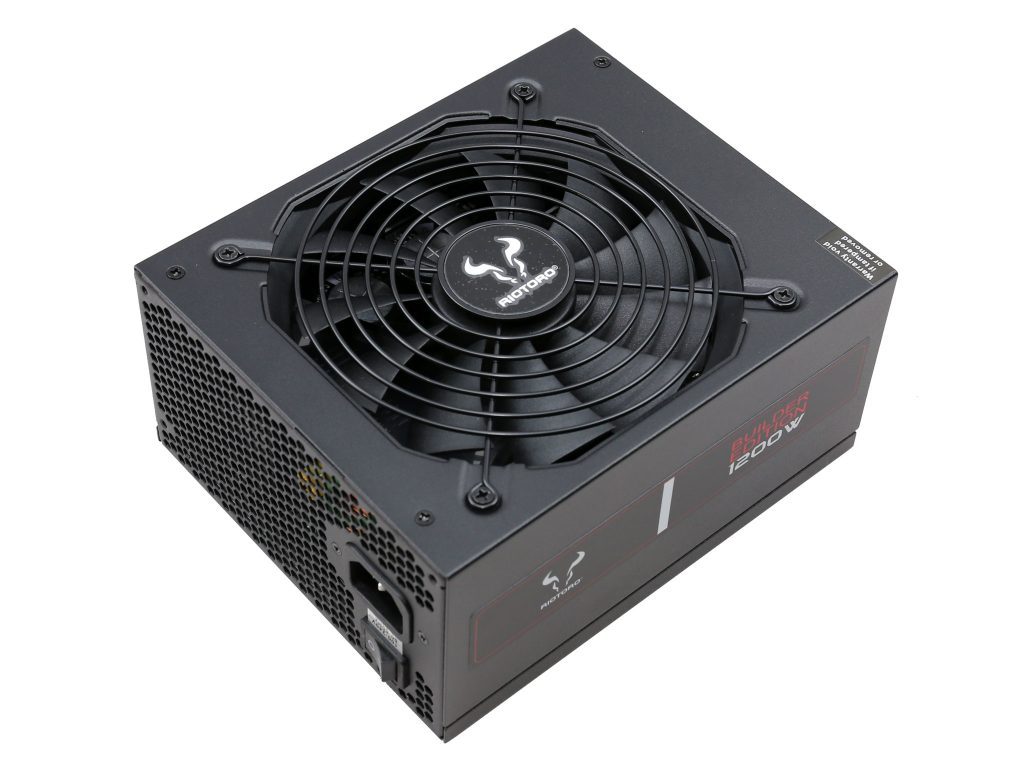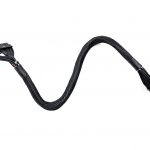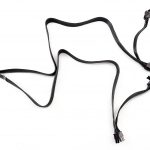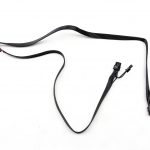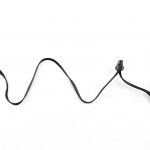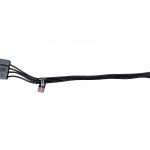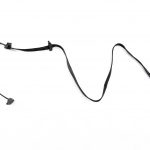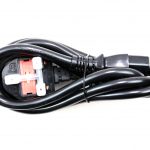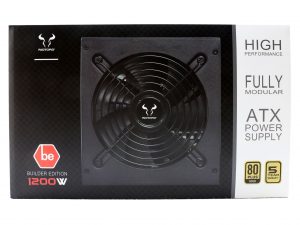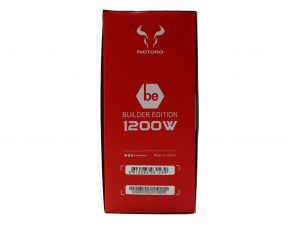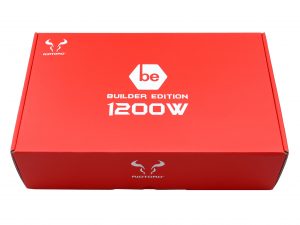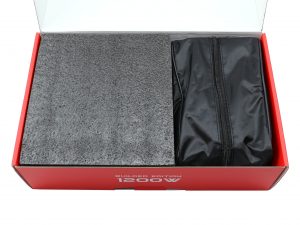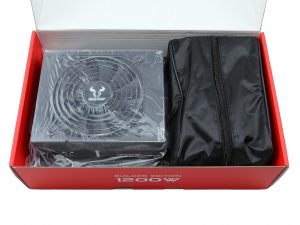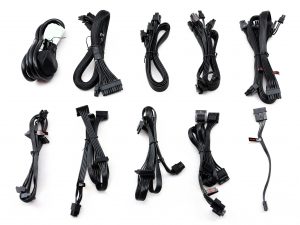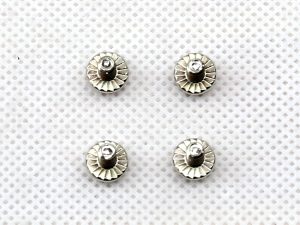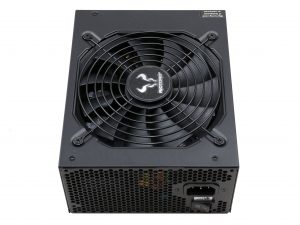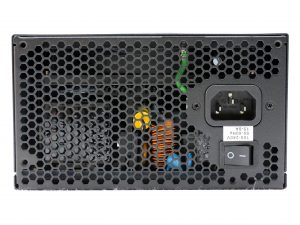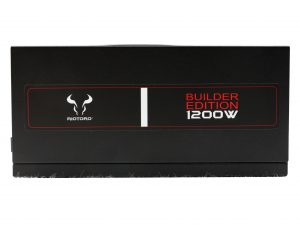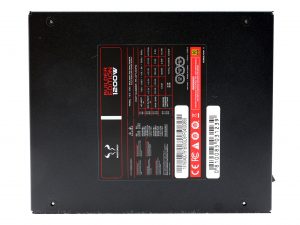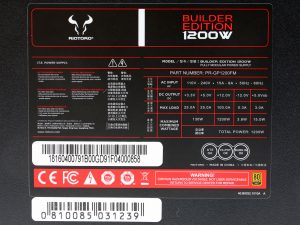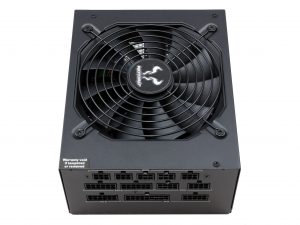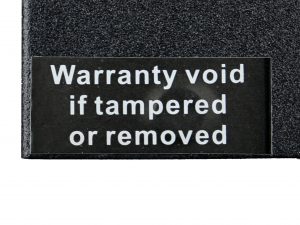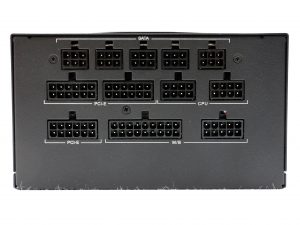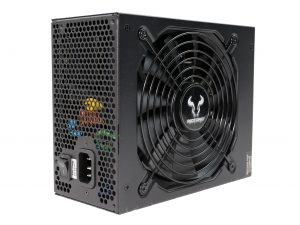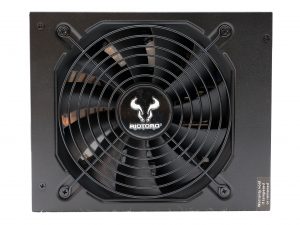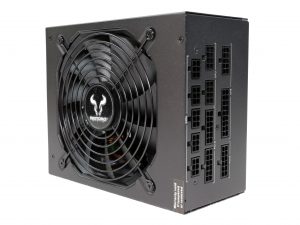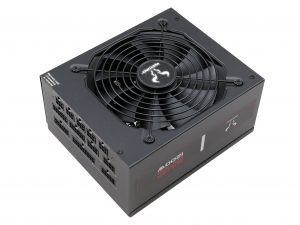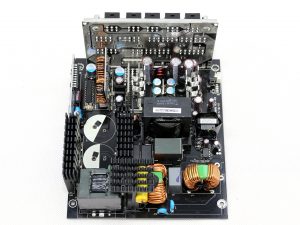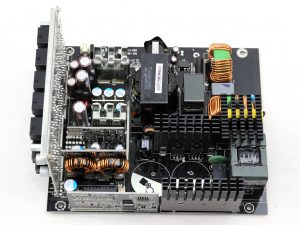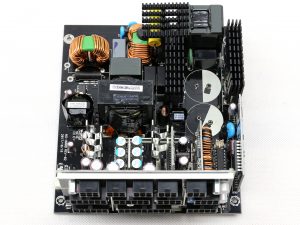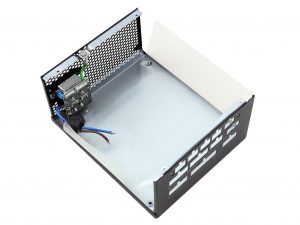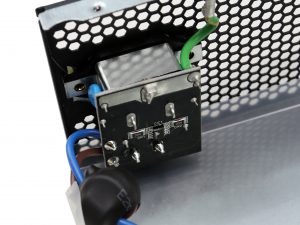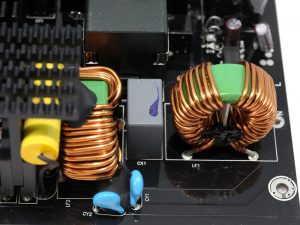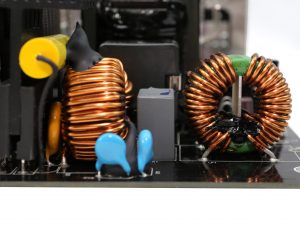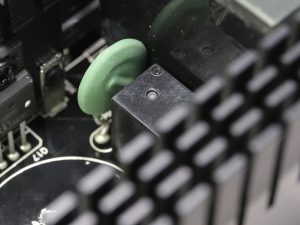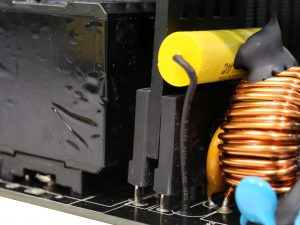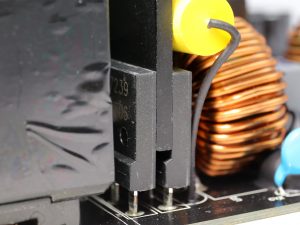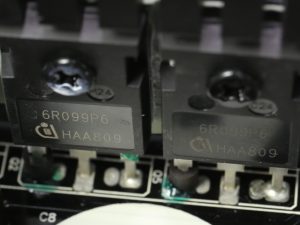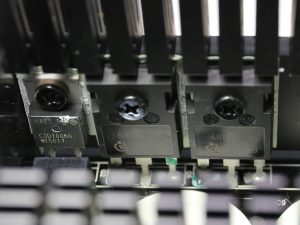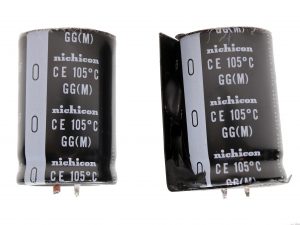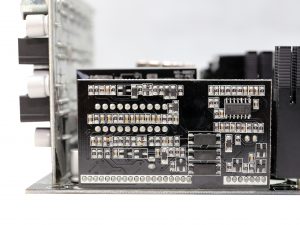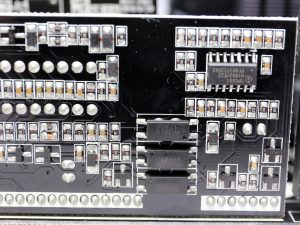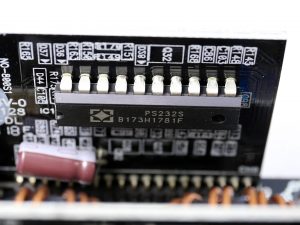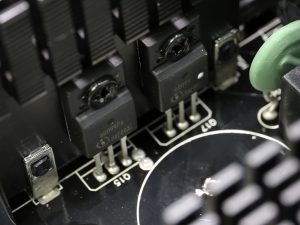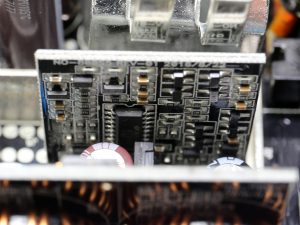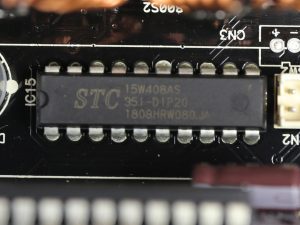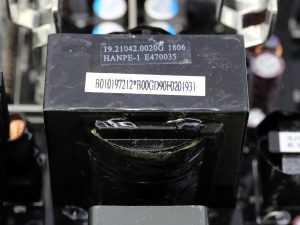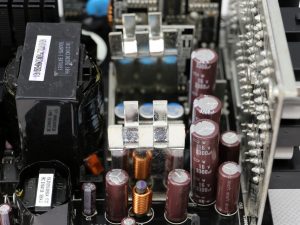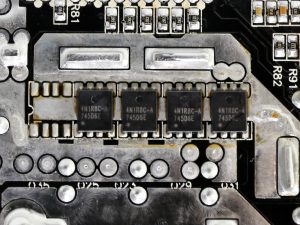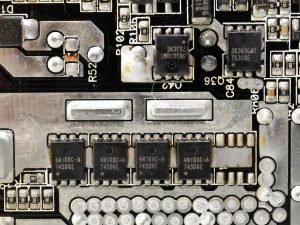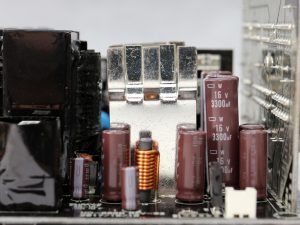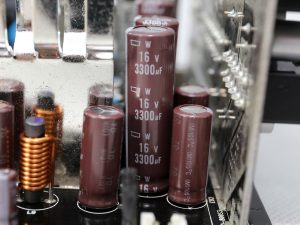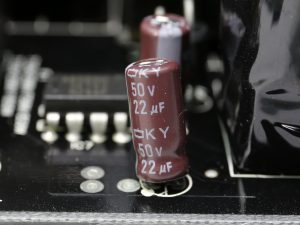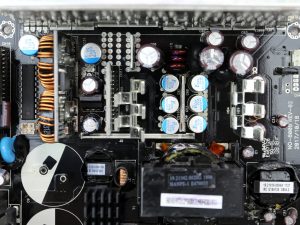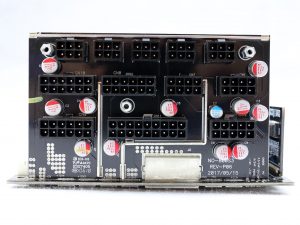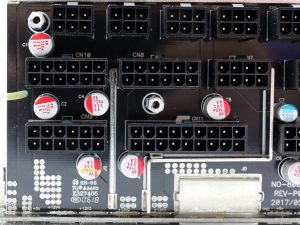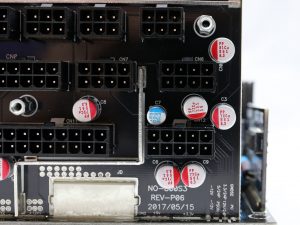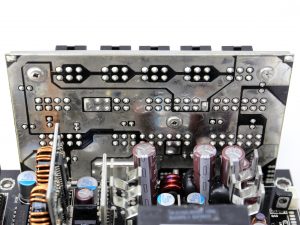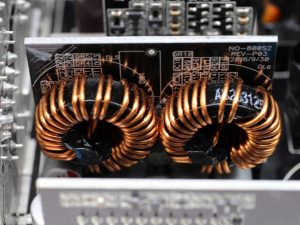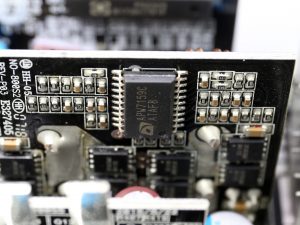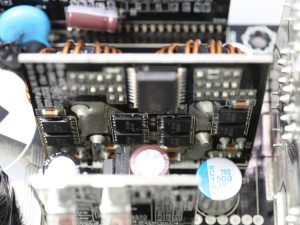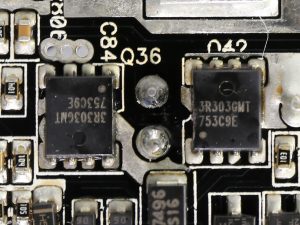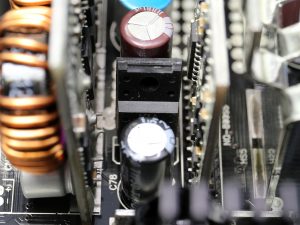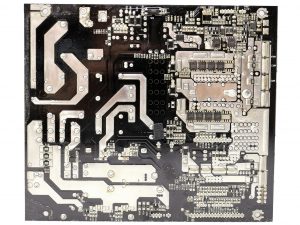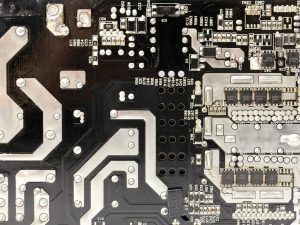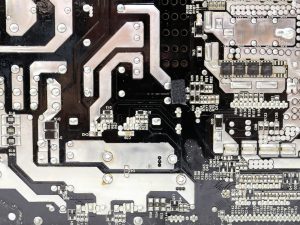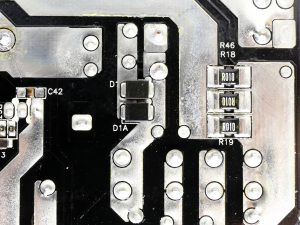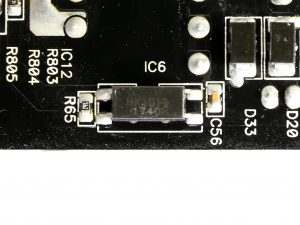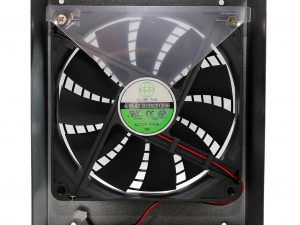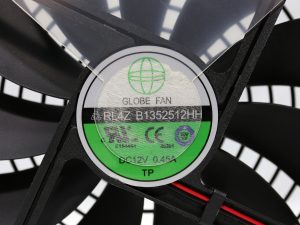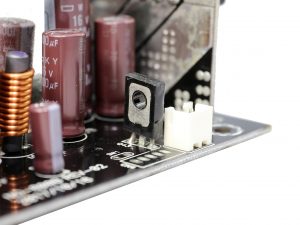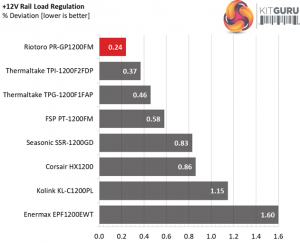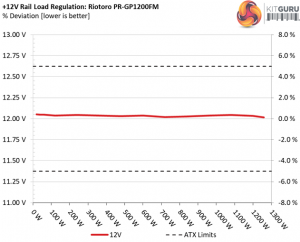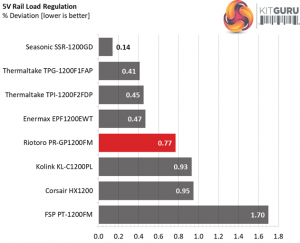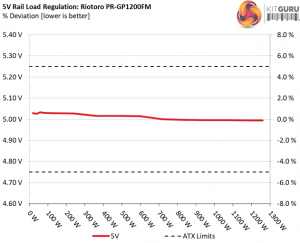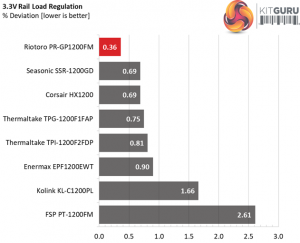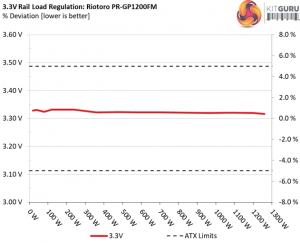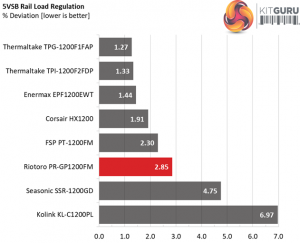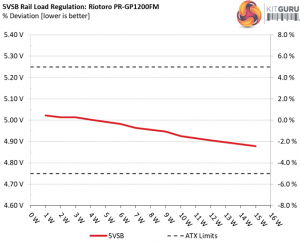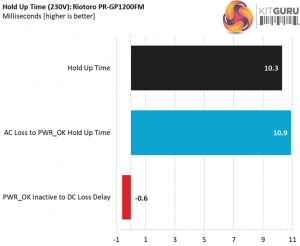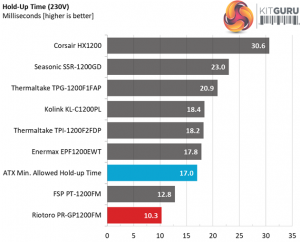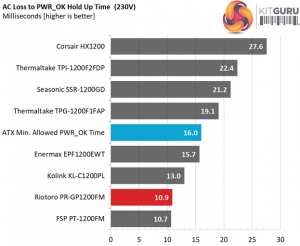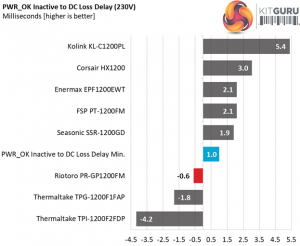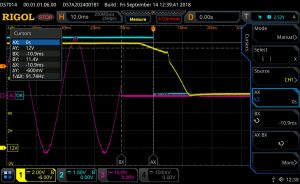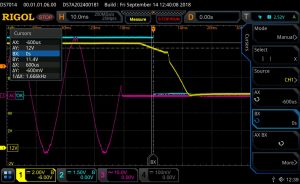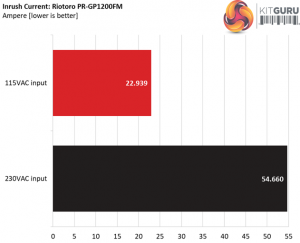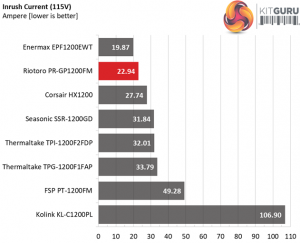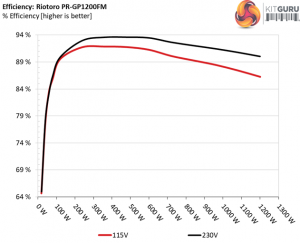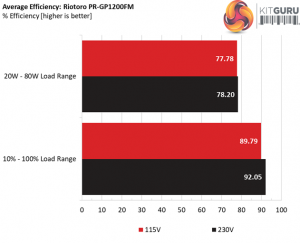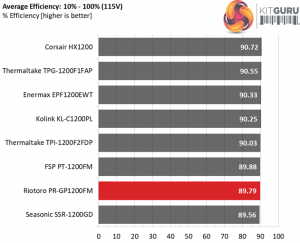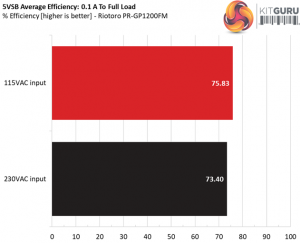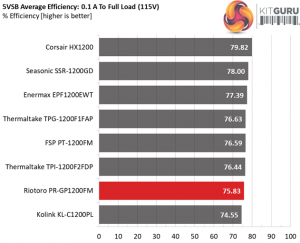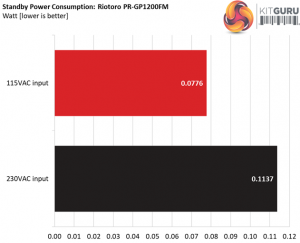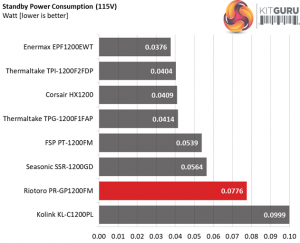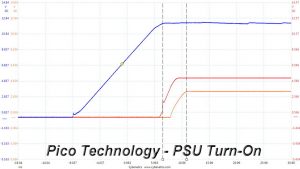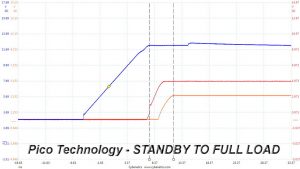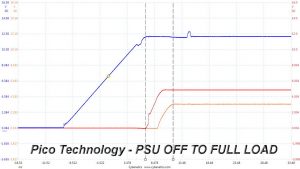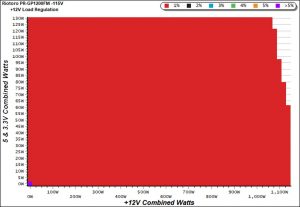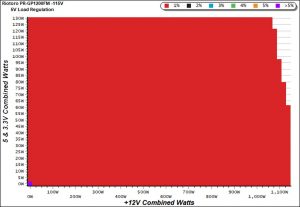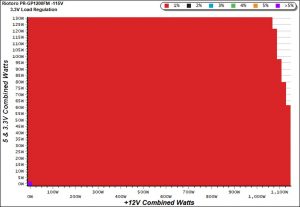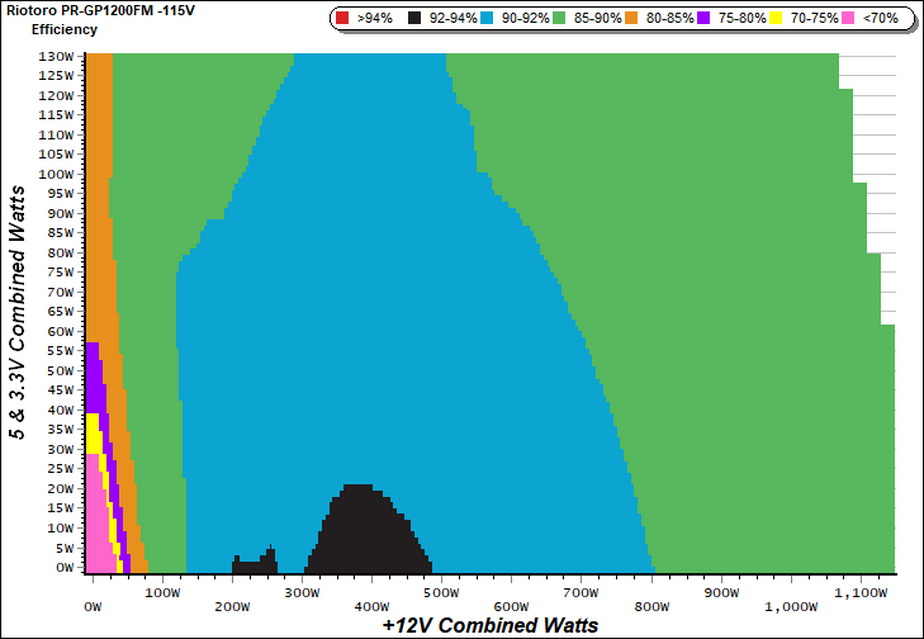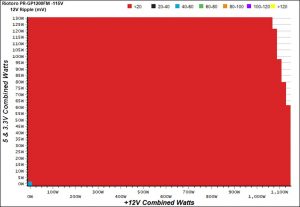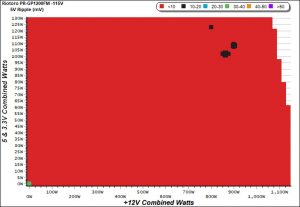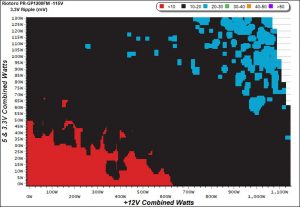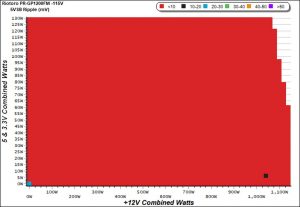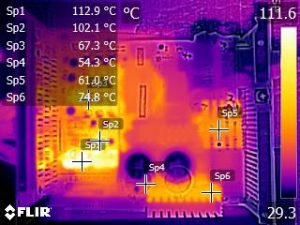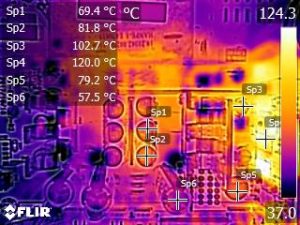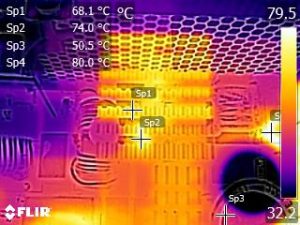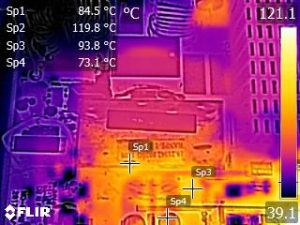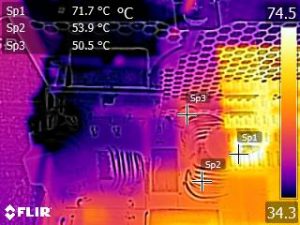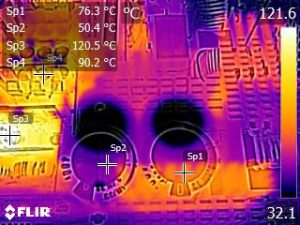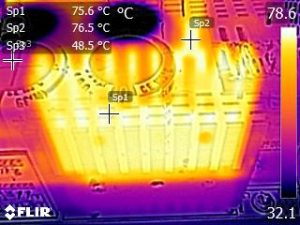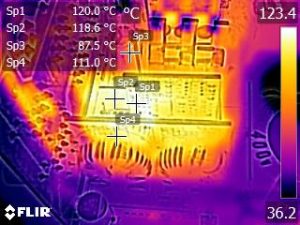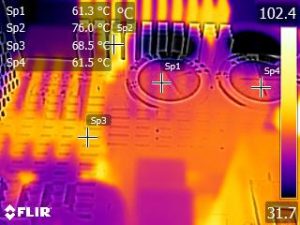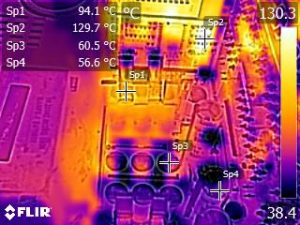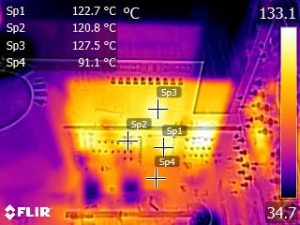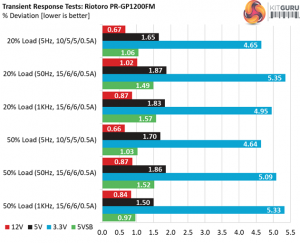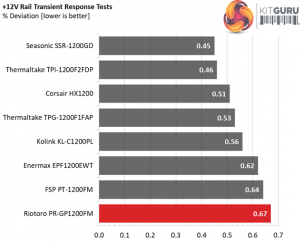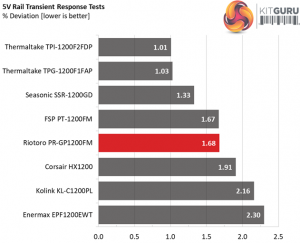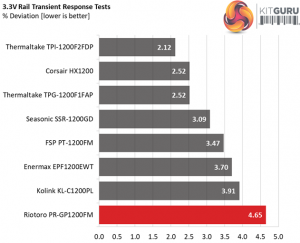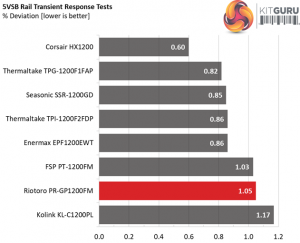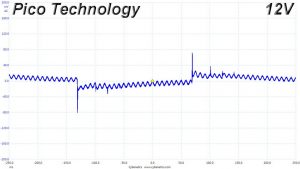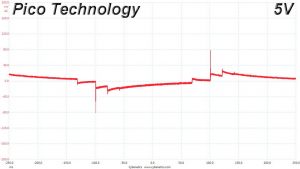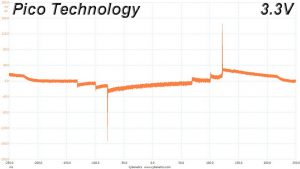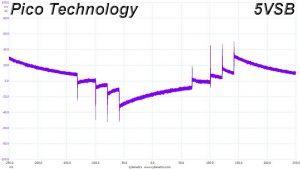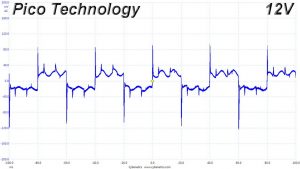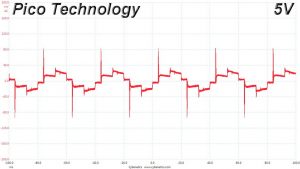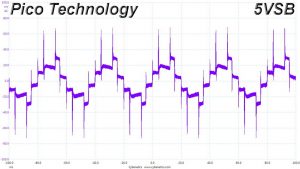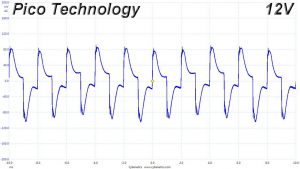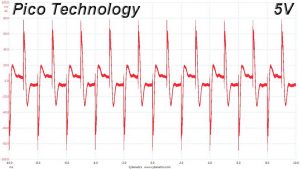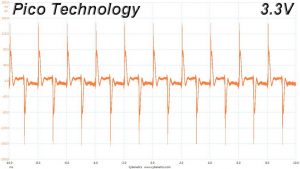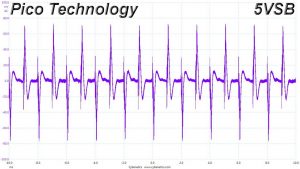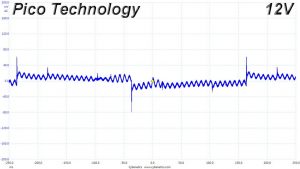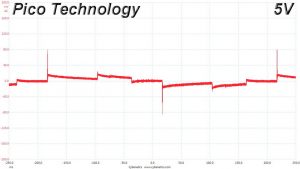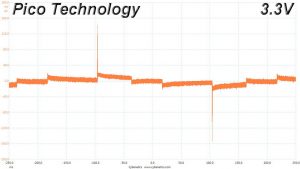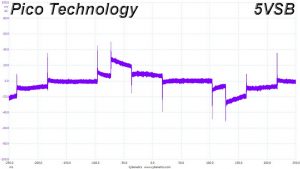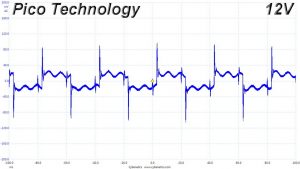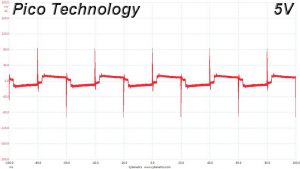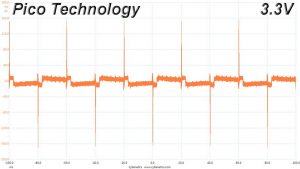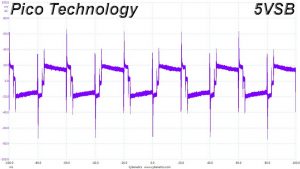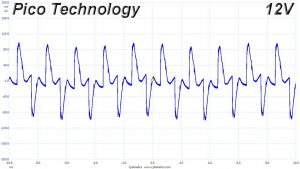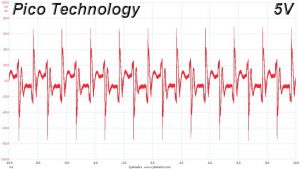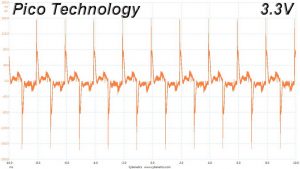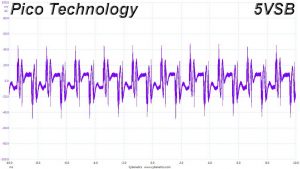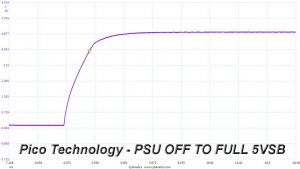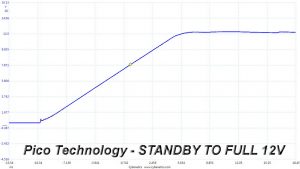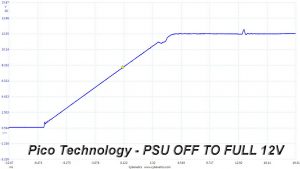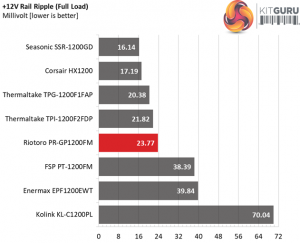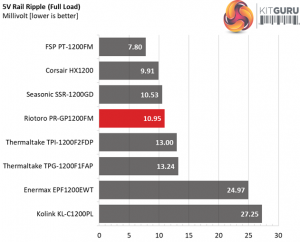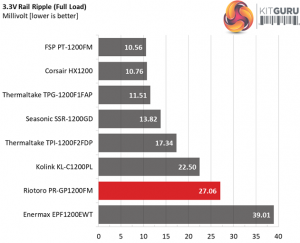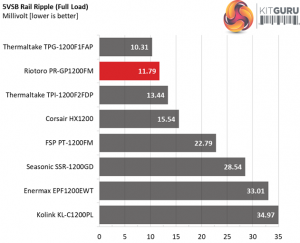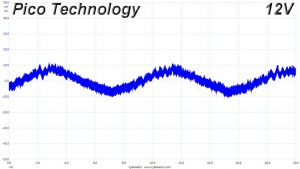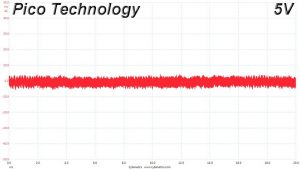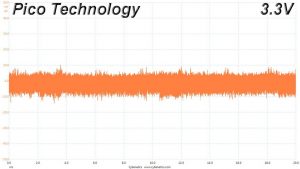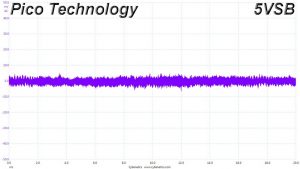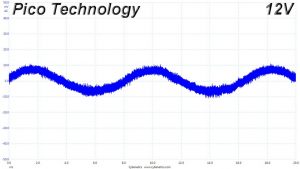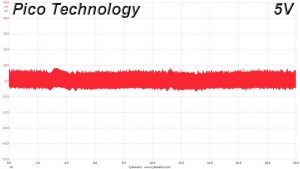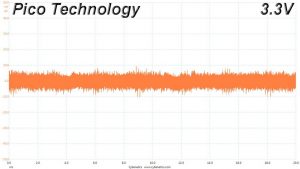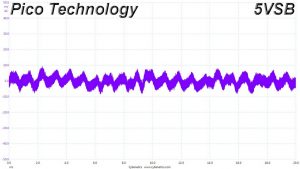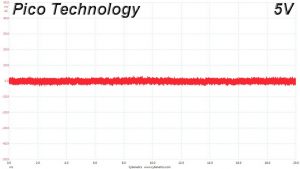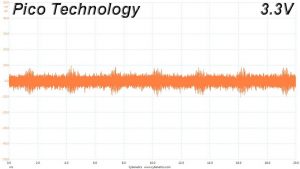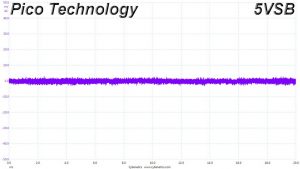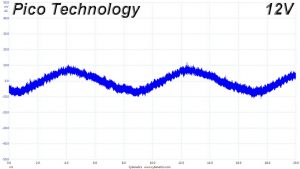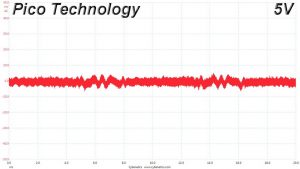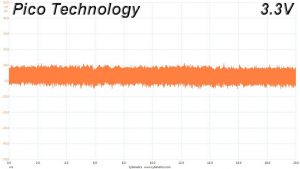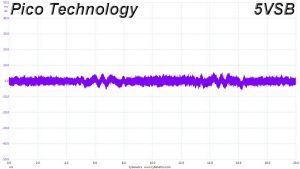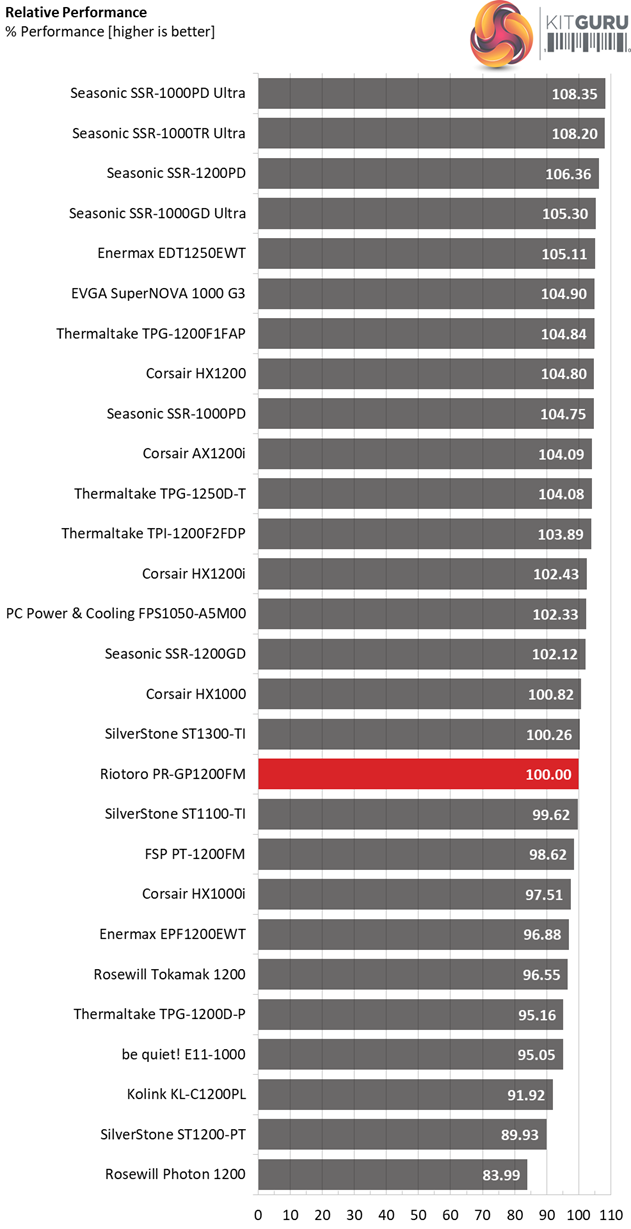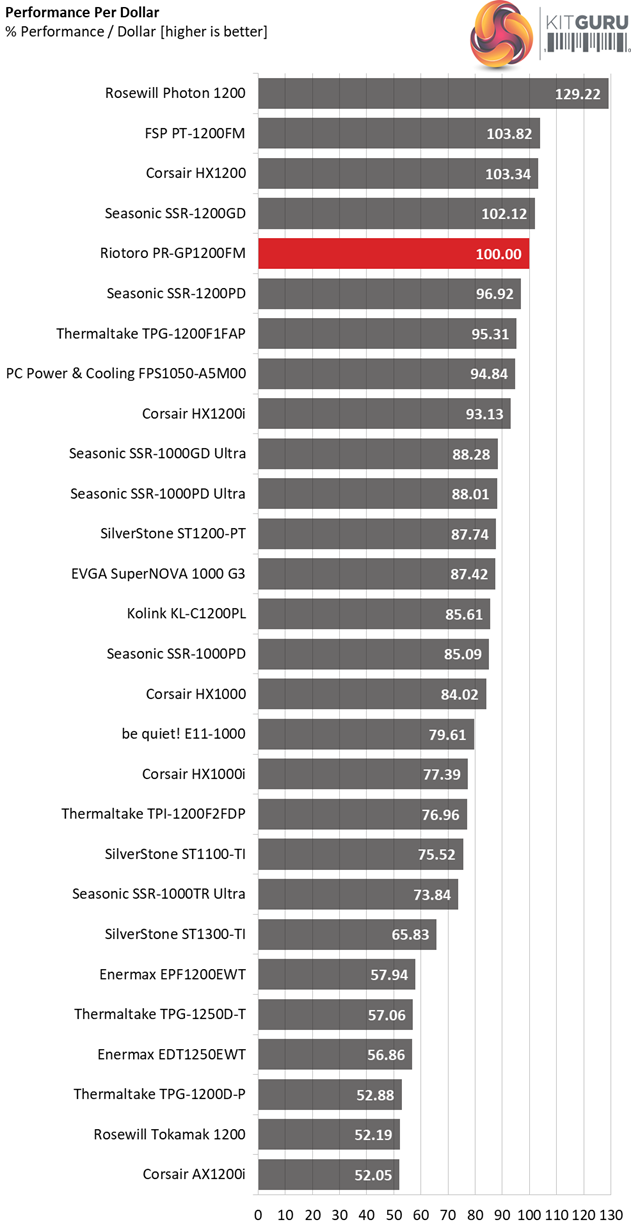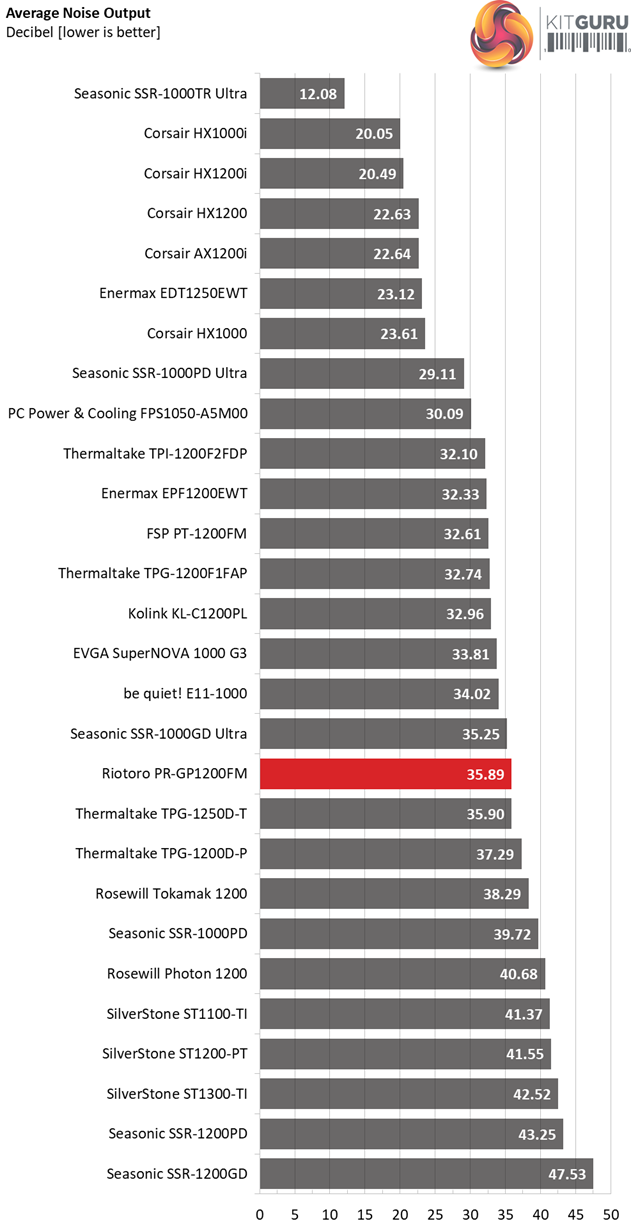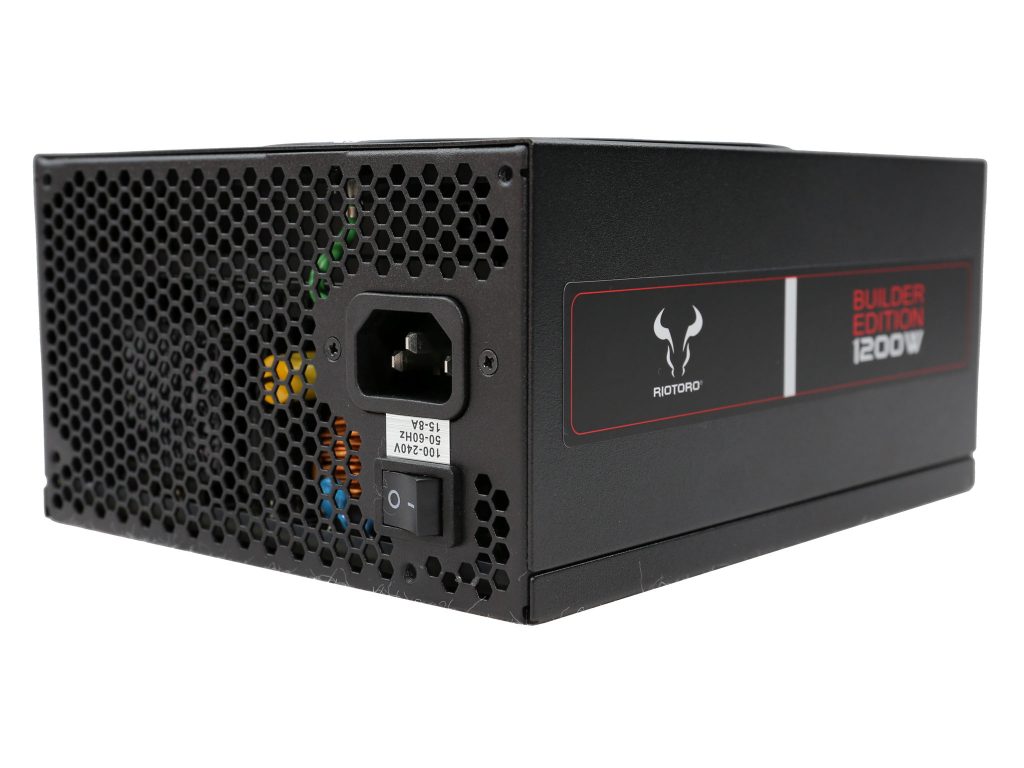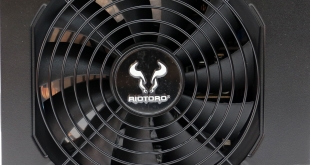
The Riotoro 1200W Builder Edition has been released for users who aren't bothered about RGB lighting, distinctive external design or other extras. It packs high power at a fair price – something that was the holy grail a few months ago, when mining with GPUs was still profitable. However, the situation has changed and with GPU mining seemingly in the past now, is this unit worth the £180 asking price?
Riotoro's Builder Edition series has so far consisted of mainstream PSUs, suitable for a run of the mill system. This makes the addition of a 1200W model look slightly odd, since the performance and wattage gap between the next tier down (a 600W unit) is huge. It seems Riotoro wanted to capitalise on the solid bang-for-buck rating its Builder series has been achieving, and thus created the 1200W model we have for review.
The impact of GPU mining was significant not only in the GPU market, but in power supplies as well, so naturally many brands wanted a piece of the pie and released high capacity PSUs, which were in high demand. The problem nowadays is that there is lots of stock of unsold PSUs with over 1kW capacity and the companies that invested money and resources into releasing similar models might never see a profit- or at least the expected one.
While that means it was understandable to go after the high capacity PSU market last year, this target market is not really a focus for the major brands anymore. There is still a market for super strong units, however this is still much more niche compared to the market for low and mid-capacity PSUs.
Read our How We Test Power Supplies HERE.
Specifications
| Manufacturer (OEM) | High Power |
| Max. DC Output | 1200W |
| Efficiency | 80 PLUS Gold, ETA-A (88-91%) |
| Noise | LAMBDA-S+ (35-40 dB[A]) |
| Modular | ✓ (Fully) |
| Intel C6/C7 Power State Support |
✓ |
| Operating Temperature (Continuous Full Load) | 0 – 50°C |
| Over Voltage Protection | ✓ |
| Under Voltage Protection | ✓ |
| Over Power Protection | ✓ |
| Over Current (+12V) Protection | ✓ |
| Over Temperature Protection | ✓ |
| Short Circuit Protection | ✓ |
| Surge Protection | ✓ |
| Inrush Current Protection | ✓ |
| Fan Failure Protection | ✗ |
| No Load Operation | ✓ |
| Cooling | 135mm Double Ball-Bearing Fan (RL4Z B1352512HH) |
| Semi-Passive Operation | ✗ |
| Dimensions (W x H x D) | 152 x 87 x 182mm |
| Weight | 1.95 kg (4.3 lb) |
| Form Factor | ATX12V v2.4, EPS 2.92 |
| Warranty | 5 Years |
Riotoro chose High Power as the OEM for its flagship PSU, mainly because this manufacturer is able to provide decent performing products at affordable prices. The registered efficiency is 80 PLUS Gold and ETA-A, while in the noise section Cybenetics awarded it with a LAMBDA-S+ badge.
All important protection features are provided, while the unit's cooling is handled by a 135mm double ball-bearing fan. Apparently Riotoro had tough conditions in mind, like mining, so it chose a DBB fan over a fluid dynamic bearing one, which can offer a quieter operation. Finally, there is no semi-passive mode available, which is a shame in such a high capacity PSU since it could help minimise the noise output under light loads.
The dimensions are normal for a 1.2kW power supply and the provided warranty is long enough at five years. More popular brands offer ten or even twelve years warranty, however we do believe that such long periods are unrealistic for PSUs.
Power Specifications
| Rail | 3.3V | 5V | 12V | 5VSB | -12V | |
| Max. Power | Amps | 25 | 25 | 100 | 3 | 0.3 |
| Watts | 130 | 1200 | 15 | 3.6 | ||
| Total Max. Power (W) | 1200 | |||||
The minor rails are quite strong for today's needs, while the +12V rail can deliver up to 100 Amps if/when needed. Finally, the 5VSB rail should be a bit stronger since this is a powerful PSU.
Cables & Connectors
| Modular Cables | ||||
| Description | Cable Count | Connector Count (Total) | Gauge | In Cable Capacitors |
|---|---|---|---|---|
| ATX connector 20+4 pin (550mm) | 1 | 1 | 16-22AWG | No |
| 4+4 pin EPS12V (650mm) | 2 | 2 | 16AWG | No |
| 6+2 pin PCIe (2x600mm) | 2 | 4 | 16AWG | No |
| 6+2 pin PCIe (600mm+150mm) | 1 | 4 | 16-18AWG | No |
| SATA (500mm+100mm+100mm+100mm) | 3 | 12 | 18AWG | No |
| 4-pin Molex (500mm+100mm+100mm) | 2 | 6 | 18AWG | No |
| FDD Adapter (+160mm) | 1 | 1 | 22AWG | No |
| AC Power Cord (1400mm) – C13 coupler | 1 | 1 | 16AWG | – |
A large number of cables and connectors are provided, including two EPS and eight PCIe connectors along with twelve SATA cables. There are also six 4-pin Molex connectors spread across two cables.
Ideally the ATX and EPS cables should be a little longer, reaching 60cm and 70cm respectively, so as to ensure they are long enough for even the biggest of modern cases. Thankfully larger, 16AWG, gauges have been used in cables that have to deal with increased amperage to lower voltage drops, though the distance between the peripheral connectors is too short at only 10cm. It should be 14-15cm at least.
The PCIe cable that uses a single 12-pin socket from the PSU's modular board, and provides four 6+2pin connectors, does trouble us as well. This implementation can put too much stress on the socket and the corresponding connector.
Packaging
On the face of the box there is a photo of the PSU with the fan grille on display. On the left side we find the model number while on the right side the major features of the PSU are highlighted. The 80 PLUS Gold badge along with an icon showing the five year warranty are also depicted on the box's front side.
On the box's side we find Riotoro's logo, the model number and a couple of bar code stickers.
At the rear side of the box, Riotoro provides some details about the PSU in six languages along with a brief description. You will also find here the 80 PLUS efficiency curve along with a list depicting the available cables and the power specifications table. There is a mention of the fan noise levels but apparently someone forgot to include the corresponding chart.
A nice red box is hiding under the package's sleeve.
Contents
The PSU is packed well into the box, since foam spacers totally surround it.
The only extra accessory you will find in the bundle is a (nice) pouch for storing the unused modular cables and the necessary fixing bolts. There are no zip ties or Velcro straps provided.
Exterior
The PSU's dimensions are on the large side, while at its front side we see the typical honeycomb-style exhaust grille along with the AC receptacle and a small power switch.
The stickers on the sides are not that fancy, while as usual the power specs sticker is installed on the unit's bottom side. Besides the power table it also depicts the serial number of the product along with some certification logos (CE and FCC).
The fully modular panel includes twelve sockets which is enough to use all of the provided cables and connectors at the same time. We are worried, though, about the single 12-pin socket that will host the cable that includes four 6+2 pin PCIe connectors, which can take huge stress if power hungry GPUs are fed through the cable. Normally no more than a pair of PCIe connectors should be fed through those 12-pin sockets. As it seems, though, there was no space for four of those sockets on the modular panel, so High Power had to do things this way.
| General Data | |
| Manufacturer (OEM) | High Power |
| Primary Side | |
| Transient Filter | 4x Y caps, 2x X caps, 2x CM chokes, 1x MOV, 1x discharge IC |
| Inrush Protection | NTC Thermistor & Relay |
| Bridge Rectifier(s) |
2x GBJ2506 (600V, 25A @ 100°C)
|
| APFC MOSFETS |
2x Infineon IPW60R099P6 (650V, 24A @ 100°C, 0.099Ohm)
|
| APFC Boost Diode |
1x CREE C3D10060 (600V, 10A @ 153°C)
|
| Hold-up Cap(s) |
2x Nichicon (400V, 560uF, 2000h @ 105 °C, GG)
|
| Main Switchers |
2x Infineon IPA60R099P6 (650V, 24A @ 100°C, 0.099Ohm)
|
| APFC Controller |
Infineon ICE3PCS01G
|
| Resonant Controller |
Champion CM6901X
|
| Topology |
Primary side: Half-Bridge & LLC Resonant Controller
Secondary side: Synchronous Rectification & DC-DC converters |
| Secondary Side | |
| +12V MOSFETS | 8x APEC AP4N1R8CMT-A (60V, 32A @ 70°C, 1.8mOhm) |
| 5V & 3.3V | DC-DC Converters: 8x APEC AP3R303GMT-HF-3 (30V, 24A @ 70°C, 3.3mOhm) PWM Controller: APW7159C |
| Filtering Capacitors | Electrolytics: Nippon Chemi-Con W (105°C), Nippon Chemi-Con (4-10,000 @ 105°C, KY) Polymers: Nippon Chemi-Con, FPCAP (FP) |
| Supervisor IC | SITI PS232S (OVP, UVP, 6x Channel OCP, SCP) |
| Micro Controller | STC 15W408AS |
| Fan Model | Globe Fan RL4Z B1352512HH (12V, 0.45A, 129.76 CFM, 1800 RPM, 33.9 dB[A], Double Ball-Bearing) |
| Fan Power Transistor | STi 2SD882 (NPN) |
| 5VSB Circuit | |
| Rectifiers |
1x PFC P10V45SP SBR (45V, 10A) & 2x APEC AP3R303GMT-HF-3 (30V, 24A @ 70°C, 3.3mOhm)
|
| Standby PWM Controller | Sanken STR-A6069H |
| -12V Circuit | |
| Rectifier |
KEC KIA7912PI (-12V, 1A)
|
The platform is provided by High Power and it appears to be a new design. It looks good since there are no power transfer cables blocking airflow and the clearance between the components is also adequate, to allow for optimal heat extraction. In particular the secondary side is quite spacious, given the max rated capacity of this unit.
The regular sized PCB plays a big part in this, since High Power didn't downsize it to make the unit smaller. Smaller PSUs are definitely easier to install, especially in chassis with restricted internal space, however when you install the same number of components in smaller PCBs, you need increase airflow to remove the heat, which inevitably leads to higher noise output levels.
The build quality is very good, reminding us of top-notch OEMs like Flextronics, Delta and Seasonic. It is nice to see High Power showing its true potential when it comes to build quality at least, since in the performance section improvements are still needed to reach the top contenders. In the primary side a half-bridge topology is used along with an LLC resonant converter. We would like to see a full-bridge topology in a high capacity unit like this one.
In the secondary side we find the typical stuff for a modern PSU – a synchronous rectification scheme for +12V and a pair of DC-DC converters for the minor rails. As a side note, we appreciate the use of a proper rectifier IC for the -12V, something that is absent even in some high-end platforms from other OEMs. This rail can still bring down the entire unit if it breaks, so it needs the best possible protection.
The PCB right behind the AC receptacle hosts two Y and one X caps along with a discharge IC, whose markings were erased so we couldn't make it the model number.
It isn't common for High Power to use NTC thermistors in its implementations, so it is nice to see those included with this platform. Not only did they install a NTC thermistor, but they have also supported it with a bypass relay.
The couple of bridge rectifiers (2x GBJ2506) can handle up to 50 Amps.
The APFC converter uses two Infineon IPW60R099P6 and a single CREE C3D10060. The bulk caps are provided by Nichicon and their combined capacity doesn't allow for a longer than 17ms hold-up time. In actual fact, the registered hold-up time is much lower, at 10.3ms.
The APFC controller, a Infineon ICE3PCS01G, sits on the same daughter-board with the supervisor IC, a SITI PS232S.
The main switching FETs are two Infineon IPA60R099P6, configured in a half-bridge topology. The LLC resonant controller which handles the main FETs along with the +12V ones is the popular Champion CM6901X. The latter is installed on a small vertical board.
There is a micro controller, a STC 15W408AS, which most likely handles some of the unit's protection features.
The unit's main transformer is quite small, given the max rated capacity of this platform.
The small heatsinks in the secondary side are used to cool down the FETs that are installed on the solder side of the main PCB, eight APEC AP4N1R8CMT-A.
The electrolytic filtering caps are provided by Chemi-Con and belong to its W and KY lines. There is no information about the W caps since those are custom made according to the customer's requirements, however there is no doubt that the KY caps are of high quality. Besides electrolytics, a large number of polymer caps from Chemi-Con and FPCAP, are also used.
At the front side of the modular board polymer caps provide an extra ripple filtering layer. At the rear side the soldering quality is good, but there are no multi-layer ceramic capacitors (MLCCs) which are ideal for high frequency ripple.
The pair of DC-DC converter utilizes eight APEC AP3R303GMT-HF-3 and the common PWM controller is a Anpec APW7159C.
The 5VSB circuit uses a single PFC P10V45SP SBR and two APEC AP3R303GMT-HF-3 FETs. The standby PWM controller is a Sanken STR-A6069H IC.
The -12V rail is rectified by a KEC KIA7912PI.
The soldering quality is impeccable- High Power did a great job in this area.
The fan's model is RL4Z B1352512HH. It is made by Globe Fan and it uses a double ball-bearing fan, which has high tolerance to increased operating temperatures. This is a mid-speed fan which is controlled by quite a relaxed speed profile. The power transistor used by the fan's control circuit, is a STi 2SD882.
To learn more about our PSU tests and methodology, please check out How We Test Power Supply Units.
Primary Rails And 5VSB Load Regulation
Load Regulation testing is detailed here.
Hold-Up Time
Our hold-up time tests are described in detail here.
The oscilloscope screenshots that we took during the hold-up time measurements:
Unfortunately the hold-up time is too small and to make matters even worse, the power ok signal is not accurate.
Inrush Current
For details on our inrush current testing, please click here.
The inrush current is low with both voltage inputs, given the unit's high capacity. Given the small capacity of the bulk caps and the proper inrush current protection, which usually is absent in High Power's platform, we didn't expect anything different here.
Load Regulation And Efficiency Measurements
The first set of tests reveals the stability of the voltage rails and the PR-GP1200FM’s efficiency. The applied load equals (approximately) 10 to 110 percent of the power supplies maximum load in increments of 10 percentage points.
We conducted two additional tests.
During the first, we stressed the two minor rails (5V and 3.3V) with a high load, while the load at +12V was only 0.1A. This test reveals whether a power supply is compatible with Intel’s C6/C7 sleep states or not. In the second test, we determined the maximum load the +12V rail could handle with minimal load on the minor rails.
| Test # | 12V | 5V | 3.3V | 5VSB | DC/AC (Watts) | Efficiency | Fan Speed (RPM) | PSU Noise (dB[A]) | Temps (In/Out) | PF/AC Volts |
| 1 | 8.173A | 1.988A | 1.979A | 1.002A | 119.969 | 89.536% | 753 | 18.3 | 40.07°C | 0.983 |
| 12.038V | 5.029V | 3.332V | 4.992V | 133.990 | 42.62°C | 115.10V | ||||
| 2 | 17.335A | 2.984A | 2.970A | 1.204A | 239.718 | 91.759% | 756 | 18.3 | 40.63°C | 0.995 |
| 12.046V | 5.027V | 3.332V | 4.983V | 261.247 | 43.82°C | 115.09V | ||||
| 3 | 26.855A | 3.489A | 3.460A | 1.410A | 359.226 | 91.878% | 1020 | 26.3 | 41.48°C | 0.996 |
| 12.036V | 5.016V | 3.322V | 4.964V | 390.980 | 45.49°C | 115.10V | ||||
| 4 | 36.448A | 3.988A | 3.971A | 1.615A | 479.681 | 91.783% | 1025 | 26.4 | 41.88°C | 0.998 |
| 12.031V | 5.016V | 3.323V | 4.956V | 522.626 | 46.65°C | 115.10V | ||||
| 5 | 45.641A | 4.987A | 4.966A | 1.820A | 599.831 | 91.285% | 1030 | 26.4 | 42.48°C | 0.998 |
| 12.036V | 5.014V | 3.322V | 4.947V | 657.095 | 49.35°C | 115.18V | ||||
| 6 | 54.927A | 6.001A | 5.960A | 2.031A | 719.937 | 90.133% | 1210 | 30.9 | 42.71°C | 0.998 |
| 12.019V | 5.000V | 3.322V | 4.926V | 798.747 | 49.50°C | 115.18V | ||||
| 7 | 64.085A | 7.004A | 6.956A | 2.238A | 839.705 | 89.303% | 1525 | 38.0 | 43.51°C | 0.999 |
| 12.025V | 4.998V | 3.321V | 4.916V | 940.290 | 51.02°C | 115.09V | ||||
| 8 | 73.251A | 8.008A | 7.951A | 2.446A | 960.138 | 88.477% | 1530 | 38.0 | 43.73°C | 0.999 |
| 12.037V | 4.996V | 3.320V | 4.906V | 1085.184 | 51.50°C | 115.09V | ||||
| 9 | 82.776A | 8.509A | 8.431A | 2.446A | 1079.501 | 87.445% | 1700 | 40.6 | 44.81°C | 0.999 |
| 12.044V | 4.996V | 3.321V | 4.906V | 1234.492 | 54.82°C | 115.09V | ||||
| 10 | 92.276A | 9.011A | 8.945A | 3.075A | 1200.011 | 86.270% | 1715 | 40.8 | 45.34°C | 0.999 |
| 12.032V | 4.995V | 3.320V | 4.879V | 1390.997 | 59.07°C | 115.10V | ||||
| 11 | 97.377A | 9.011A | 8.957A | 3.071A | 1259.722 | 86.507% | 1695 | 40.6 | 28.37°C | 0.999 |
| 12.015V | 4.994V | 3.316V | 4.886V | 1456.200 | 42.37°C | 115.09V | ||||
| CL1 | 0.142A | 16.001A | 16.000A | 0.000A | 135.073 | 83.302% | 760 | 18.4 | 40.11°C | 0.984 |
| 12.068V | 5.020V | 3.316V | 5.029V | 162.149 | 50.09°C | 115.12V | ||||
| CL2 | 89.297A | 1.001A | 0.998A | 1.000A | 1086.254 | 87.932% | 1690 | 40.5 | 29.85°C | 0.999 |
| 12.015V | 5.003V | 3.318V | 4.971V | 1235.336 | 41.13°C | 115.10V |
When tested at up to 50% load, the fan spins at low speeds, hence the unit's noise is kept low. It starts to get noticeable in the next test and in the worst case scenario it barely exceeds 40 dB(A). The fan profile is not aggressively tuned, that's for sure, since even with full load at 45°C it doesn't allow the fan to spin at its full speed.
Unfortunately the PSU isn't able to deliver 110% of its full power but it can go up to 105% only (1260W) and this is at normal operating temperatures and not >40°C. It isn't also able to deliver more than 90 Amps on the +12V rail during the CL2 test, although its paper specifications mention about 100A on this rail. Those facts lead us to believe that High Power was super conservative with the over power and over current protection features.
With 20% and 50% of its max-rated capacity the unit meets the 80 PLUS Gold standard's requirements, but with full load it fells short. Nonetheless, we apply much more stress than 80 PLUS since we test with higher temperatures, so efficiency takes a hit.
The load regulation is very tight on all rails, especially at +12V which is the most important rail.
Efficiency
Our efficiency testing procedure is detailed here.
Using results from the previous page, we plotted a chart showing the PR-GP1200FM’s efficiency at low loads, and loads from 10 to 110 percent of its maximum-rated capacity.
The majority of the competing products in this capacity range feature higher efficiency certifications and cost more. So it is natural for the Riotoro offering to be at the bottom of the normal-load average efficiency chart. The unit takes over first place though, in the light loads chart.
Efficiency At Low Loads
In the following tests, we measure the PR-GP1200FM's efficiency at loads significantly lower than 10 percent of its maximum capacity (the lowest load the 80 PLUS standard measures). The loads we dial are 20, 40, 60, and 80W. This is important for representing when a PC is idle, with power-saving features turned on.
| Test # | 12V | 5V | 3.3V | 5VSB | DC/AC (Watts) | Efficiency | Fan Speed (RPM) | PSU Noise (dB[A]) | PF/AC Volts |
| 1 | 1.192A | 0.497A | 0.479A | 0.199A | 19.458 | 64.642% | 750 | 18.3 | 0.859 |
| 12.051V | 5.029V | 3.329V | 5.022V | 30.101 | 115.10V | ||||
| 2 | 2.455A | 0.995A | 0.989A | 0.399A | 39.870 | 77.368% | 750 | 18.3 | 0.934 |
| 12.047V | 5.026V | 3.331V | 5.013V | 51.533 | 115.11V | ||||
| 3 | 3.651A | 1.490A | 1.471A | 5.013A | 59.384 | 83.305% | 753 | 18.3 | 0.960 |
| 12.048V | 5.034V | 3.327V | 5.013V | 71.285 | 115.10V | ||||
| 4 | 4.914A | 1.987A | 1.985A | 0.800A | 79.782 | 85.820% | 753 | 18.3 | 0.970 |
| 12.044V | 5.031V | 3.324V | 5.002V | 92.964 | 115.10V |
With light loads the 1.2kW unit goes pretty well, while at the same time the fan's noise is kept low.
5VSB Efficiency
The ATX specification (revision 1.4), along with CEC, ErP Lot 3 2014 and ErP Lot 6 2010/2013, states that the 5VSB standby supply efficiency should be as high as possible, recommending 75 percent or higher with 550mA, 1A, and 1.5A of load.
The supply should also achieve higher than 75% efficiency at 5VSB under full load, or with 3A if its max current output on this rail is higher than 3A.
We take six measurements: one each at 100, 250, 550, 1000, and 1500mA, and one with the full load the 5VSB rail can handle.
| Test # | 5VSB | DC/AC (Watts) |
Efficiency | PF/AC Volts |
| 1 | 0.100A | 0.510 | 70.442% | 0.084 |
| 5.097V | 0.724 | 115.12V | ||
| 2 | 0.250A | 1.273 | 75.459% | 0.176 |
| 5.092V | 1.687 | 115.11V | ||
| 3 | 0.550A | 2.796 | 79.140% | 0.290 |
| 5.083V | 3.533 | 115.11V | ||
| 4 | 1.000A | 5.070 | 79.405% | 0.376 |
| 5.069V | 6.385 | 115.12V | ||
| 5 | 1.500A | 7.582 | 79.618% | 0.423 |
| 5.054V | 9.523 | 115.10V | ||
| 6 | 3.000A | 15.002 | 78.030% | 0.479 |
| 5.000V | 19.226 | 115.10V |
The 5vSB rail's efficiency is satisfactory, although the majority of the (more expensive) offerings achieve better results here.
Power Consumption In Idle And Standby
In the table below, you’ll find the power consumption and voltage values of all rails (except -12V) when the PSU is idle (powered on, but without any load on its rails), and the power consumption when the unit is in standby mode (without any load, at 5VSB).
| Mode | 12V | 5V | 3.3V | 5VSB | Watts | PF/AC Volts |
| Idle | 12.064V | 5.024V | 3.334V | 5.025V | 10.043 | 0.552 |
| 115.1V | ||||||
| Standby | 0.078 | 0.009 | ||||
| 115.1V | ||||||
The vampire power is a bit higher than expected, especially with 230V. This affects the 5VSB's efficiency under very light loads.
Fan RPM, Delta Temperature, And Output Noise
Our mixed noise testing is described in detail here.
The first chart below illustrates the cooling fan's speed (in RPM), and the delta between input and output temperature. The results were obtained at 37°C (98.6°F) to 45°C (113°F) ambient temperature.
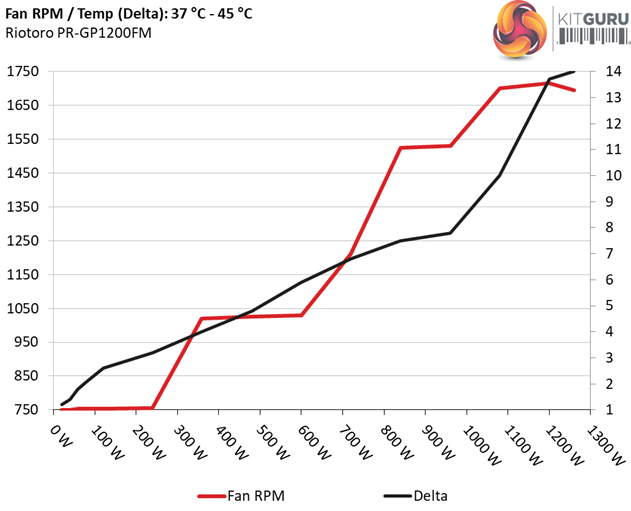
The next chart shows the fan's speed (again, in RPM) and output noise. We measure acoustics from one meter away, inside a hemi-anechoic chamber. Background noise inside the chamber is below 6 dB(A) during testing (it's actually much lower, but our sound meter’s microphone hits its floor), and the results are obtained with the PSU operating at 37°C (98.6°F) to 45°C (113°F) ambient temperature.
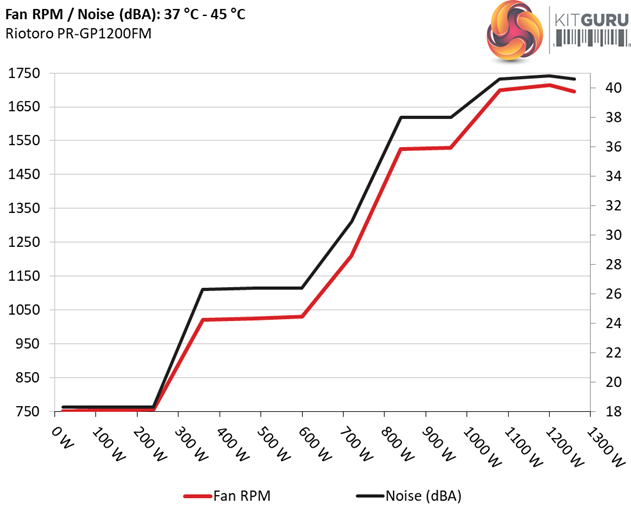
The following graph illustrates the fan's output noise over the PSU's operating range. The same conditions of the above graph apply to our measurements, though the ambient temperature is between 30°C (86°F) to 32°C (89.6°F).
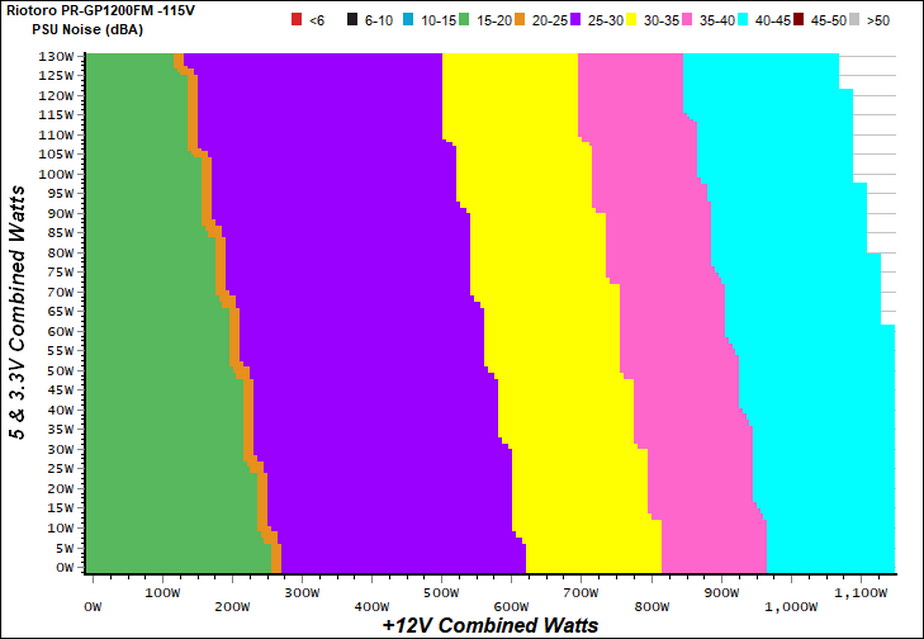
If we take into account the fan control circuit's behaviour under high operating temperatures, we expected it to be more relaxed under normal operating temperatures. Nonetheless, this is a high capacity unit so it needs to have proper airflow to ensure the internal components take the least amount of stress, in order to maximise lifespan.
With up to 290W at +12V the PSU is silent, while with up to 610W it will probably stay below most user's noise radar. In the worst case scenario, which is over 970W load at +12V, the fan's noise barely exceeds 40 dB(A).
Protection Features
Our protection features evaluation methodology is described in detail here.
|
Protection |
|
|
OCP |
12V: 99A (0.99%), 11.999V |
|
OPP |
1259.722W (104.97%) |
|
OTP |
✓ (185°C @ 12V Heat Sink) |
|
SCP |
12V: ✓ |
|
PWR_OK |
Does not function correctly |
|
NLO |
✓ |
|
SIP |
Surge: MOV |
After many tries we were able to draw close to 100 Amps from the +12V rail, before the unit shuts down. Riotoro say we should be able to draw 100 Amps on this rail, so we cannot say that we are left satisfied by the result. For a strange reason this rail's OCP is wrongly configured although the +12V FETs can easily cope with much higher loads.
The minor rails are able to deliver more watts than their nominal ratings, while the over power protection's triggering point is very close to the unit's max rated capacity. As it seems High Power wanted to stay on the (extra) safe side, it was very conservative with this platform's major protection features.
The over temperature protection is present and operates properly, though the power ok signal is not accurate, which is a great shame for a product like this priced at £180
DC Power Sequencing
According to Intel’s most recent Power Supply Design Guide (revision 1.4) the +12V and 5V voltages must be equal or greater than the 3.3V rail’s output at all times, during the power-up and normal operation. For our first measurement, we turn the unit off and switch it back on without any load in any of the rails.
In the second test, we set the PSU to standby mode, dial full load and start it afterwards. In the last test, while the power supply is completely switched off (we cut off the power or switch the supply off through its power switch), we dial full load before restoring power.
The 3.3V rail's voltage is always lower than the rest two rails, as the ATX spec demands.
Our cross-load tests are described in detail here.
To generate the following charts, we set our loaders to auto mode through our custom-made software before trying more than 1500 possible load combinations with the +12V, 5V, and 3.3V rails. The load regulation deviations in each of the charts below are calculated by taking the nominal values of the rails (12V, 5V, and 3.3V) as point zero. The ambient temperature is between at 30°C (86°F) to 32°C (89.6°F).
Load Regulation Charts
Efficiency Chart
There are two small regions where the efficiency levels exceed 92%. In the majority of cases this is a clear indication of a “good” 80 PLUS Gold unit.
Ripple Charts
Infrared Images
We apply half-load for 10 minutes with the PSU’s top cover and cooling fan removed before taking photos with our modified FLIR E4 camera that delivers 320×240 IR resolution (76,800 pixels).
We measure high temperatures on the DC-DC converters, because we push them enough with close to 10 Amps load on each of the minor rails. The temperatures on the rest of the parts are low enough given the operating conditions.
Advanced Transient Response Tests
For details on our transient response testing, please click here.
These tests are crucial because they simulate the transient loads a PSU is likely to handle (such as booting a RAID array or an instant 100 percent load on CPU/GPUs). We call these “Advanced Transient Response Tests” and they are designed to be very tough to master, especially for a PSU with a capacity of less than 500W.
In all of the tests, we use an oscilloscope to measure the voltage drops caused by the transient load. The voltages should remain within the ATX specification's regulation limits.
We should note that the ATX spec requires for capacitive loading during the transient rests, but in our methodology we chose to apply the worst case scenario with no extra capacitance on the rails.
Advanced Transient Response at 20 Percent – 200ms
| Voltage | Before | After | Change | Pass/Fail |
|---|---|---|---|---|
| 12V | 12.067V | 11.986V | 0.67% | Pass |
| 5V | 5.026V | 4.943V | 1.65% | Pass |
| 3.3V | 3.330V | 3.175V | 4.65% | Pass |
| 5VSB | 4.982V | 4.929V | 1.06% | Pass |
Advanced Transient Response at 20 Percent – 20ms
| Voltage | Before | After | Change | Pass/Fail |
|---|---|---|---|---|
| 12V | 12.042V | 11.919V | 1.02% | Pass |
| 5V | 5.025V | 4.931V | 1.87% | Pass |
| 3.3V | 3.330V | 3.152V | 5.35% | Pass |
| 5VSB | 4.981V | 4.907V | 1.49% | Pass |
Advanced Transient Response at 20 Percent – 1ms
| Voltage | Before | After | Change | Pass/Fail |
|---|---|---|---|---|
| 12V | 12.037V | 11.932V | 0.87% | Pass |
| 5V | 5.024V | 4.932V | 1.83% | Pass |
| 3.3V | 3.330V | 3.165V | 4.95% | Pass |
| 5VSB | 4.981V | 4.903V | 1.57% | Pass |
Advanced Transient Response at 50 Percent – 200ms
| Voltage | Before | After | Change | Pass/Fail |
|---|---|---|---|---|
| 12V | 12.030V | 11.951V | 0.66% | Pass |
| 5V | 5.011V | 4.926V | 1.70% | Pass |
| 3.3V | 3.321V | 3.167V | 4.64% | Pass |
| 5VSB | 4.946V | 4.895V | 1.03% | Pass |
Advanced Transient Response at 50 Percent – 20ms
| Voltage | Before | After | Change | Pass/Fail |
|---|---|---|---|---|
| 12V | 12.025V | 11.920V | 0.87% | Pass |
| 5V | 5.010V | 4.917V | 1.86% | Pass |
| 3.3V | 3.321V | 3.152V | 5.09% | Pass |
| 5VSB | 4.945V | 4.870V | 1.52% | Pass |
Advanced Transient Response at 50 Percent – 1ms
| Voltage | Before | After | Change | Pass/Fail |
|---|---|---|---|---|
| 12V | 12.022V | 11.921V | 0.84% | Pass |
| 5V | 5.009V | 4.934V | 1.50% | Pass |
| 3.3V | 3.321V | 3.144V | 5.33% | Pass |
| 5VSB | 4.944V | 4.896V | 0.97% | Pass |
The unit's transient response is quite good at +12V, with the deviations proving to be similar to the competition. The 5V rail has low voltage drops and the same applies to the 5VSB rail. Only the 3.3V rail performs poorly here, since besides high deviations it also drops its voltage below 3.2V in all tests.
Here are the oscilloscope screenshots we took during Advanced Transient Response Testing:
Transient Response At 20 Percent Load – 200ms
Transient Response At 20 Percent Load – 20ms
Transient Response At 20 Percent Load – 1ms
Transient Response At 50 Percent Load – 200ms
Transient Response At 50 Percent Load – 20ms
Transient Response At 50 Percent Load – 1ms
Turn-On Transient Tests
In the next set of tests, we measure the PR-GP1200FM’s response in simpler transient load scenarios—during its power-on phase.
For our first measurement, we turn the PSU off, dial in the maximum current the 5VSB rail can handle, and switch the PSU back on.
In the second test, we dial the maximum load the +12V rail can handle and start the PSU while it is in standby mode. In the last test, while the PSU is completely switched off (we cut off the power or switch the PSU off through its power switch), we dial the maximum load the +12V rail can handle before restoring power. The ATX specification states that recorded spikes on all rails should not exceed 10 percent of their nominal values (+10 percent for 12V is 13.2V, and 5.5 V for 5V).
Very good results here. We only notice a small spike during the last test, which is nothing to worry about.
To learn how we measure ripple, please click here.
The following table includes the ripple levels we measured on the PR-GP1200FM’s rails. The limits, according to the ATX specification, are 120mV (+12V) and 50mV (5V, 3.3V, and 5VSB).
| Test | 12V | 5V | 3.3V | 5VSB | Pass/Fail |
| 10% Load | 7.9 mV | 5.7 mV | 10.0 mV | 6.1 mV | Pass |
| 20% Load | 10.4 mV | 5.9 mV | 11.1 mV | 5.9 mV | Pass |
| 30% Load | 11.0 mV | 6.5 mV | 12.3 mV | 6.6 mV | Pass |
| 40% Load | 11.2 mV | 7.1 mV | 13.7 mV | 7.1 mV | Pass |
| 50% Load | 12.1 mV | 8.1 mV | 15.0 mV | 7.8 mV | Pass |
| 60% Load | 11.6 mV | 9.3 mV | 17.2 mV | 8.5 mV | Pass |
| 70% Load | 12.7 mV | 9.5 mV | 19.1 mV | 8.2 mV | Pass |
| 80% Load | 13.6 mV | 11.0 mV | 22.9 mV | 10.0 mV | Pass |
| 90% Load | 13.4 mV | 11.2 mV | 24.8 mV | 10.8 mV | Pass |
| 100% Load | 23.8 mV | 11.0 mV | 27.1 mV | 11.8 mV | Pass |
| 105% Load | 16.6 mV | 12.7 mV | 24.5 mV | 12.1 mV | Pass |
| Crossload 1 | 11.2 mV | 7.4 mV | 21.3 mV | 7.6 mV | Pass |
| Crossload 2 | 23.2 mV | 12.4 mV | 23.0 mV | 12.2 mV | Pass |
The ripple suppression is pretty good on all rails. Please do note that with 105% load we measure less ripple because we conducted this test at a much lower temperature compared to the 100% test. We were forced to do this because the PSU kept shutting down with anything higher than 100% of its max rated capacity, under high operating temperatures.
Ripple Oscilloscope Screenshots
The following oscilloscope screenshots illustrate the AC ripple and noise registered on the main rails (+12V, 5V, 3.3V and 5VSB). The bigger the fluctuations on the screen, the bigger the ripple/noise. We set 0.01 V/Div (each vertical division/box equals 0.01V) as the standard for all measurements.
Ripple At Full Load
Ripple At 110-Percent Load
Ripple At Cross-Load 1
Ripple At Cross-Load 2
To learn more about our EMI testing equipment, please check out How We Test Power Supply Units.
EMI Results – Average Detector
Everything is fine with the average detector.
EMI Results – Peak Detector
No problems at all with the peak EMI detector.
Performance Rating
The following graph shows the PR-GP1200FM’s total performance rating, comparing it to other units we have tested. To be more specific, the tested unit is shown as the 100 percent baseline, and every other unit's performance is shown relative to it.
The Riotoro 1200W unit achieves a high overall performance score, however the competition is strong as you can see in the graph above. Both the HX1200 and the Prime Gold 1200W perform better, while they also cost about the same and have much longer warranty periods.
Performance Per Dollar
The following chart may be the most interesting to many of you because it depicts the product’s performance-per-dollar score. We looked up the current price of each PSU from popular online etailers and used those prices and all relative performance numbers to calculate the index. Note that all of the numbers in the following graphs are normalised by the rated power of each unit.
Riotoro's model scores well, however the HX1200 and the SSR-1200GD perform better. With a lower price this unit would be even more attractive, but we don't know if this is possible for Riotoro (and High Power).
Noise Rating
The graph below depicts the cooling fan's average noise over the PSU's operating range, with an ambient temperature between 30°C and 32°C (86°F to 89.6°F).
For a 1200W unit it is quiet enough. Just take a look at the similar capacity models with higher efficiency, with many of them exceeding 40 dB(A) overall noise output. Nevertheless, the HX1200 is significantly quieter.
Efficiency Rating
The following graph shows the PSU's average efficiency throughout its operating range, with an ambient temperature close to 30°C.

There are not many 1200W Gold units, so naturally the PR-GP1200FM is at the bottom of this chart. The difference between it and the Seasonic Prime Gold model is very small though.
The Riotoro 1200W Builder Edition PSU has an MSRP of $220 in the US while in the UK market is sold for £180 (including VAT). A few months ago 220 dollars was a good price for a quality 1200W unit, but nowadays we can find better PSUs for the same amount of money, so Riotoro will have to push the price lower to stay competitive. This might not be possible, though.
The Builder Edition 1200W is clearly built for tough conditions, given the double ball-bearing fan and the tightly configured protection features (OPP and OCP at +12V). Most likely Riotoro had mining in its focus during the design phase of this product. There is no doubt though that the GPU mining era has finished, thankfully, and powerful PSUs are not so popular now.
Nonetheless, they are still necessary for high-end systems equipped with multiple GPUs and/or multi-core CPUs. For example, my colleague Leo measured 450W power consumption under load with the Powenetics system from an overclocked Threadripper 2990WX processor, with the system's overall power consumption reaching 830W. The test system was equipped with a single EVGA GTX 1080 Ti, so with an additional 1080 Ti the power consumption could easily exceed 1.1kW. This means that strong power supplies are still essential for the enthusiasts who want to build a highly capable system either for gaming or for multi-thread applications like video editing.
High Power provided a solid platform to Riotoro, but it is not flawless. Although its overall performance is pretty high, coming close to models like the HX1200 and the SSR-1200GD, I didn't like the very tight over power protection and the fact that the unit had a problem delivering its full power at +12V alone due to a wrongly configured OCP on this rail, something that should be trouble-free according to its official specifications.
Moreover, I am not so fond of the single PCIe cable which is split in two, with each cable hosting a pair of 6+2pin PCIe connectors. This means that a single 12pin socket on the modular panel has to handle the amperage of four PCIe connectors, so if you use a pair of power hungry GPUs things can easily go south and you might have to deal with melted connectors.
The low hold-up time is partially justified by the increased cost of the bulk caps, however I am not at all happy with the false power ok signal since it provides inaccurate voltage information to the system's mainboard, forcing sensitive components to have to deal with lower than expected input voltages.
It is good to see a double ball-bearing fan in a PSU which is meant for tough conditions, though, since this type of fan is able to deal with high temperatures much better than fluid/hydro dynamic bearing fans. The fan profile is not aggressive and this partially compensates for the lack of a semi-passive mode.
In general this product is worthy of consideration since it offers good performance and the platform's build quality is also very good. Nonetheless, because of the low interest in high capacity units at the moment, you can find a number of great offerings at the same price, including the Corsair HX1200 and the Seasonic Prime Gold 1200W. This means that the Riotoro 1200W Builder Edition PSU will need to drop the pricing to remain competitive.
You can buy the Riotoro 1200W Builder Edition PSU from CCL for £179.98 HERE.
Pros:
- Great build quality.
- Pretty high overall performance.
- Tight load regulation.
- Efficient.
- Good ripple suppression (without using in-cable caps).
- Good transient response on all rails but 3.3V.
- Silent under normal operating conditions.
- Plenty of connectors including 2x EPS and 8x PCIe.
- Double ball-bearing fan, suitable for operation under high temperatures.
- 5-year warranty (however the competition provides 10-12 years)
Cons:
- Many high wattage units are now available for the same price.
- The OPP and OCP at +12V are not properly set.
- A single 12-pin socket has to deal with four 6+2 pin PCIe connectors.
- Low hold-up time.
- Inaccurate power-ok signal.
- 3.3V rail transient response.
- Lacks a semi-passive mode.
- Short distance (100mm) between the peripheral connectors.
KitGuru says: This is a solid PSU, offered at a fair price tag, however the recent drop in demand of high-capacity PSUs had as a notable effect on their prices. This means that, while it was released at a competitive price, nowadays you can find better units for the same price.
Be sure to check out our sponsors store EKWB here
 KitGuru KitGuru.net – Tech News | Hardware News | Hardware Reviews | IOS | Mobile | Gaming | Graphics Cards
KitGuru KitGuru.net – Tech News | Hardware News | Hardware Reviews | IOS | Mobile | Gaming | Graphics Cards


